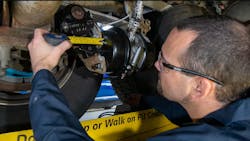What components make up a quality maintenance program?
A variety of factors have to come together for a maintenance program to be truly effective. Each element has to work with the others if a fleet is going to get the most out if its maintenance efforts.
Here are the elements of a good fleet maintenance program. Make sure your maintenance provider is on board with your goals in each of these areas.
Driver involvement
The driver is an important part of vehicle maintenance. I would almost argue it can be the most important part. They can spot a problem at its very early stages often by noting a change in the sound of the vehicle or a slight difference in the way it accelerates or brakes.
That is why you need to stress the importance of pre- and post-trip inspections. When we do something on a routine basis, we can fall into the trap of not giving it the attention it deserves. Remind your drivers of the importance of attention to detail when it comes to their pre- and post-trip inspections. Any problem that is reported on a Driver Vehicle Inspection Report (DVIR), has a chance of being repaired before the next time the driver gets into the truck.
See also: When diagnosing equipment, remember the driver
Not only does that mean the truck is ready when the driver has available hours of service, but it can also prevent an on-road breakdown or an out-of-service violation during a roadside inspection.
Technician engagement
Make sure your technicians are taking driver complaints seriously and are responding to items noted on DVIRs not only by completing the repairs but also closing the feedback loop for items they were not able to repair or problems they were unable to duplicate.
In addition, reinforce the importance of performing thorough preventive maintenance inspections whenever the vehicle is in the shop. Hopefully, any problems found when a truck is already in for service can be repaired at that time, avoiding the need to bring the truck back to the shop for additional service.
Ongoing training
Truck technology is constantly evolving, so too must your training efforts. Make sure you are offering training for all new technologies being spec’d on your trucks but also offer refresher courses for some of the prominent maintenance issues.
Data analytics
Today fleet managers have myriad data about each asset in their fleet. Sensors and telematics devices are throwing off data as trucks move down the road. In addition, there is a great deal of information that should be captured during every service event.
See also: Why fleets should digitize their maintenance management system
Someone needs to be tasked with analyzing that data and spotting wear and failure trends. This will allow the fleet to make changes to each vehicle’s maintenance schedule and to improve maintenance practices throughout the shop.
When all of these elements—and any others that you have identified that are specific to your organization—work together, your vehicles will operate more efficiently and be on the road longer.
Gino Fontana, CTP, is COO and EVP at Transervice Logistics Inc. Prior to this, he was VP of operations at Berkeley Division and Puerto Rico. He has more than 35 years of experience in the transportation and logistics industry with both operational and sales experience.
About the Author
Gino Fontana
Chief operating officer and executive vice president at Transervice Logistics Inc.
Gino Fontana, CTP, is COO and EVP at Transervice Logistics Inc. His operational expertise emphasizes cost savings, process efficiency and improvement, superior quality, and people management skills. He has more than 35 years of experience in the transportation and logistics industry with both operational and sales experience.
